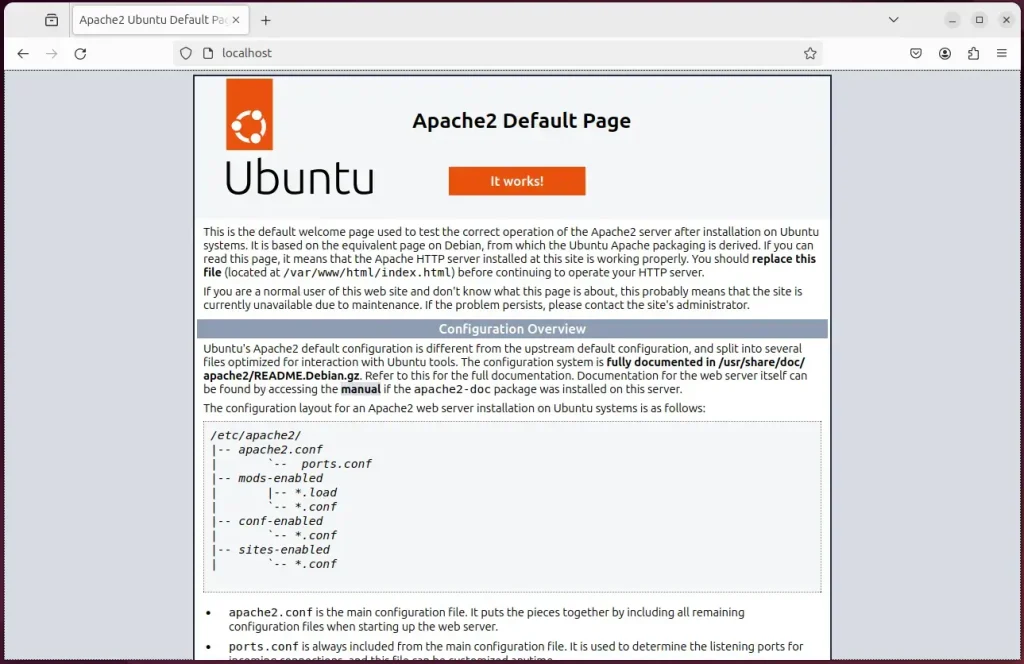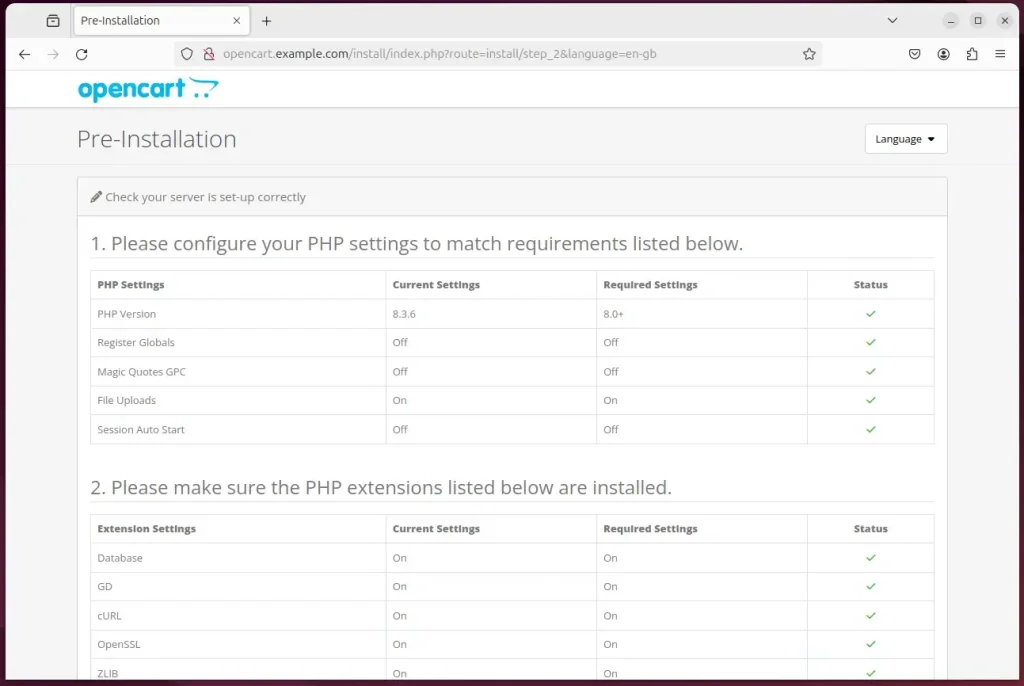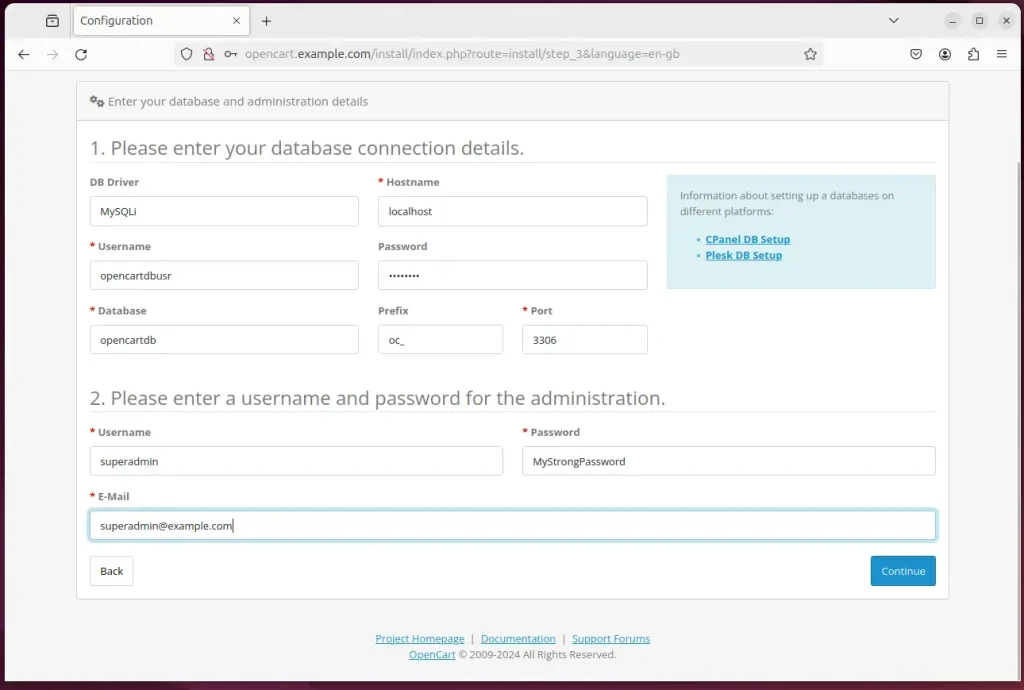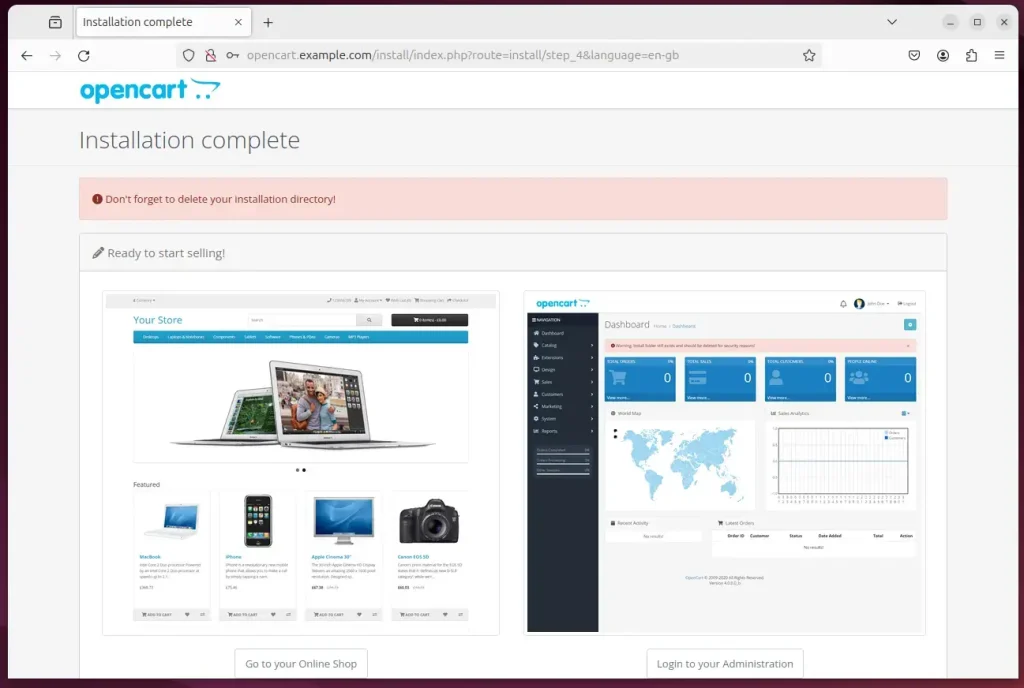This article explains how to install OpenCart with Apache on Ubuntu 24.04.
Installing OpenCart with Apache on Ubuntu brings with it a multitude of benefits. Apache, a widely used and well-supported web server, is known for its stability and performance. Ubuntu, a widespread and user-friendly Linux distribution, is often the preferred choice for server deployments.
This powerful combination empowers you to fully take advantage of Apache’s robust features and security options while benefiting from Ubuntu’s ease of use and flexibility. The large and active communities of Apache and Ubuntu further enhance this sense of empowerment, ensuring you can easily find support and resources if you run into any issues.
The steps below walk you through installing OpenCart with Apache on Ubuntu 24.04.
Install Apache HTTP server on Ubuntu
OpenCart requires a web server. This post will install and use the Apache web server to run OpenCart.
To do that, open the Ubuntu terminal and run the commands below to install the Apache web server.
sudo apt update
sudo apt install apache2
Once Apache is installed, the commands below can start, stop, and enable the Apache web server to start automatically when your server boots up.
sudo systemctl stop apache2
sudo systemctl start apache2
sudo systemctl enable apache2
You can test that the Apache web server is running by opening your web browser and browsing to the server’s localhost or IP address.
http://localhost

When you see the Apache2 Default Page, it means the Apache HTTP server is successfully installed.
Additional help on installing Apache on Ubuntu is in the link below.
How to install Apache on Ubuntu
Install the MariaDB database server on Ubuntu
The next component required to run OpenCart is a database server. This post will install and use the MariaDB database server.
To install and use the MariaDB database server, use the instructions below.
Open the Ubuntu terminal and run the commands below to install the MariaDB database server.
sudo apt update sudo apt install mariadb-server
Once the MariaDB database server is installed, use the commands below to stop, start, and enable the MariaDB server to start automatically when the server boots.
sudo systemctl stop mariadb sudo systemctl start mariadb sudo systemctl enable mariadb
Run the following commands to validate and test if the MariaDB database server is installed successfully.
sudo mariadb
Once you run the commands above, it will log you onto the MariaDB console and display a message similar to the one below.
Welcome to the MariaDB monitor. Commands end with ; or \g. Your MariaDB connection id is 32 Server version: 10.11.2-MariaDB-1 Ubuntu 23.04 Copyright (c) 2000, 2018, Oracle, MariaDB Corporation Ab and others. Type 'help;' or '\h' for help. Type '\c' to clear the current input statement. MariaDB [(none)]>
The message tells you that the server is installed successfully.
Additional help on installing MariaDB.
Create an OpenCart database
Upon successful installation of the MariaDB database server, create a blank database on the server specifically for the OpenCart application.
As part of the setup, we will create an opencartdb database and a corresponding user account called opencartdbuser.
Finally, we’ll grant the opencartdbuser full access to the opencartdb database.
All the database steps above can be done using the commands below:
But first, log on to the MariaDB database server:
sudo mariadb
Then run the commands below to complete the steps:
CREATE DATABASE opencartdb CHARACTER SET utf8mb4 COLLATE utf8mb4_general_ci;
CREATE USER opencartdbuser@localhost IDENTIFIED BY 'type_your_password_here';
GRANT ALL ON opencartdb.* TO opencartdbuser@localhost WITH GRANT OPTION;
FLUSH PRIVILEGES;
exit
Ensure to replace ‘type_your_password_here ‘with your password.
Install PHP on Ubuntu Linux
The last component you will need to run OpenCart is PHP. The OpenCart application is PHP-based and supports the latest versions of PHP.
Run the commands below to install PHP.
sudo apt install php libapache2-mod-php php-intl php-mysql php-curl php-cli php-zip php-xml php-gd php-common php-mbstring php-xmlrpc php-json php-sqlite3 php-soap php-zip
Additional help on installing PHP
How to install PHP on Ubuntu Linux
Download OpenCart files
Let’s begin downloading and configuring the OpenCart files on Ubuntu Linux.
To always install the latest version, check the OpenCart’s download page. If a new version is available, replace the version number in the link below.
First, navigate to the /tmp/ directory and download OpenCart files. After unzipping the file, move the content into the OpenCart folder in the Apache root directory.
The final step is to change the permissions. This will allow the Apache web server to safely interact with the files, ensuring a secure environment for your OpenCart installation.
cd /tmp
wget https://github.com/opencart/opencart/releases/download/4.0.2.3/opencart-4.0.2.3.zip
unzip opencart-4.0.2.3.zip
sudo mv opencart-*/upload/ /var/www/opencart
Next, create the config files and allow Apache to use them.
sudo cp /var/www/opencart/config-dist.php /var/www/opencart/config.php
sudo cp /var/www/opencart/admin/config-dist.php /var/www/opencart/admin/config.php
sudo chown -R www-data:www-data /var/www/opencart
Once you have completed all the above steps, continue configuring the Apache web server below to serve the OpenCart content.
Run the commands below to create an Apache virtual host file for OpenCart.
sudo nano /etc/apache2/sites-available/opencart.conf
Then, copy and paste the content block below into the Apache server block.
<VirtualHost *:80>
ServerName opencart.example.com
ServerAlias www.opencart.example.com
ServerAdmin [email protected]
DocumentRoot /var/www/opencart
<Directory /var/www/opencart/>
Options FollowSymlinks
AllowOverride All
Require all granted
</Directory>
ErrorLog ${APACHE_LOG_DIR}/error.log
CustomLog ${APACHE_LOG_DIR}/access.log combined
</VirtualHost>
Save the file.
Then, run the commands below to enable the virtual host and restart the Apache server.
sudo a2ensite opencart.conf
sudo a2enmod rewrite
sudo systemctl restart apache2
Setup Let’s Encrypt SSL/TLS for OpenCart
You may want to install an SSL/TLS certificate to secure your OpenCart site. Secure your OpenCart installation with HTTPS from Let’s Encrypt.
Please read the post below for additional resources on installing and creating Let’s Encrypt SSL certificates for Apache.
How to set up Let’s Encrypt SSL certificate for Apache on Ubuntu Linux
Once you have restarted the Apache web server, open your browser and browse to the server hostname or IP address defined in the Apache server block.
http://opencart.example.com
An OpenCart installation wizard page should appear. Ensure all requirements are met and continue.

Next, enter the database name, create an account and password, and continue.

Your OpenCart site should be set up and ready to use.

Don’t forget to delete your installation directory!
sudo rm -rf /var/www/opencart/install/
That should do it!
Conclusion:
- Combining the Apache web server and Ubuntu Linux distribution empowers users to use robust features, security options, and ease of use.
- The installation of OpenCart involves setting up Apache, MariaDB, and PHP on Ubuntu, creating an OpenCart database, and downloading the necessary files.
- Securing the OpenCart site with a Let’s Encrypt SSL/TLS certificate ensures users a safe and encrypted browsing experience.
- Following the comprehensive guide outlined in this article allows users to successfully set up an OpenCart site on Ubuntu with Apache support, providing a solid foundation for e-commerce endeavors.

Leave a Reply